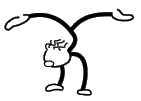


Romanian gymnasts take flight in hybrid show
Octavio Roca, Chronicle Dance Critic
Monday, January 22, 2001
©2001 San Francisco Chronicle
URL: http://www.sfgate.com/cgi-bin/article.cgi?file=/chronicle/archive/2001/01/22/DD185623.DTL
Alot can be said about Aeros, above all that it works. This explosive fusion of gymnastics and modern dance landed on the Zellerbach Hall stage Saturday night, bringing just the sort of thing art hopes for and seldom achieves: surprise.
The mix is certainly original. Aeros is a new troupe made up entirely of athletes from the Romanian Gymnastics Federation, including five world champions and many who doubtless will be. Their moves on stage have been guided by a trio of American choreographers in collaboration with Luke Cresswell and Steve McNicholas, the creators of "Stomp."
It is a strange combination of sensibilities. Yet art and sports find common ground in entertainment and -- make no mistake -- Aeros smiles through the best of both worlds. There is something ineffably beautiful about Aeros, and also something very exciting. At the same time, it has none of the pretensions of Elizabeth Streb's trampoline work, seen a while back on the Zellerbach stage.
The show is a suite of dances, all of them short and most of them ending up with superhuman feats on parallel bars, trampolines or just simply in the air. The first image is of a beautiful man suspended high above the stage, falling silently into darkness. A feast of jumps and scissor kicks follows as the whole cast enters in a frenzy of bodies approaching the condition of flight: floor dives that make nonsense of gravity, semaphoric upper-body gestures that suggest enigmas in motion, slow and syncopated cartwheels that draw aureolas of limbs in space.
In a running gag throughout the show, a young man clutching a flower chases a woman, catches up with her and is in turn tumbled to the floor as she triumphantly salutes the crowd with the flair of a seasoned acrobat. Later there is a daisy chain of push-ups on a bouncing jungle gym. Six schoolgirls perform a jumping-jacks routine to the amplified sounds of their own stomping feet. A postmodern game of musical chairs asks how many shirtless hunks can dance on a bar stool, then a sort of strip poker without cards moves the action atop a table.
A sequence under black light, with the dancers stretching and crossing strips of elastic rope, comes off as an homage to Alwin Nikolais that I think old Nik would have enjoyed. Elsewhere, when bodies not only touch but also seem to meld into one moving form, the work of Pilobolus comes to mind. More often, though, there are echoes of those rhythmic socialist Spartachiades that these Romanians are mercifully too young to remember.
The music, by Canada's Two Tall Guys and their TTG Music Lab, is mostly harmless New Age pap but at times comes close to Future Sounds of London and better electronica riffs. There is definitely an exuberant Europop feel to this very athletic affair, something that will not surprise gymnastics fans but may upset the Puritan sensibilities of American modern-dance lovers. The follow-through in dance phrases is not always polished, and the actual language of the movement is as limited as it is clear. But these are quibbles.
The truth is that no one said Aeros is supposed to be dance: Daniel Ezrarow,
David Parsons and Moses Pendleton are established choreographers, yet the program bills them as directors; the actual choreography is thin and finds resolution in what amounts to floor exercises. But this is not the point.
Aeros captures the visceral thrill of Olympic gymnastics, caresses it into a more intimate level and glories in the natural grace of the human body. This is no small achievement. The bodies in question, each a prime exemplar of classical perfection and proportion, cut figures on stage that Praxiteles himself would have been proud to call his own. Sculptural beauty, an elusive virtue in dance, is the rule in Aeros.
It doesn't hurt that these 20 Romanian gymnasts are not only attractive but also so very likable. That is a gift. And the fact that there are strong personalities on stage goes a long way to explain the cheers at Zellerbach. Aeros lists a roster of performers but doesn't identify the individual dances or dancers in the program, and that is a pity. These Romanians deserve to be better known. And Aeros deserves its success.
E-mail Octavio Roca at oroca@sfchronicle.com
©2001 San Francisco Chronicle